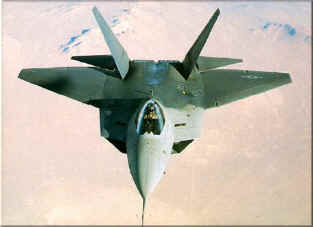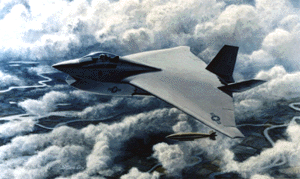Advances in technology continue rapidly, but fielding new equipment is a lengthy process for the U.S. military. The first F-22s will reach operational units in FY 2005, 14 years after the first F-22 test flight. The F-22 was conceived as a pure fighter aircraft to defeat advanced Soviet MIGs. The Soviet Union collapsed, the advanced MIGs were never built, so the F-22 program reinvented itself as a fighter/bomber aircraft. This required extensive modifications and delayed production.
As a result, much of the technology for the "new" F-22 is considered a generation old. For example, the avionics were custom designed for a 25MHz computer chip, while new home computers are produced with 1400MZs chips. Meanwhile, research for the new Joint Strike Fighter (JSF) has produced cheaper and superior technology, which has led many to speculate that the F-35 Joint Strike Fighter will outperform the expensive F-22 designed a decade earlier.


The Obsolete F-22 The F-35, a quantum leap
The biggest JSF breakthrough has been Active Electronically Scanned Array (AESA) radar which can scan, track, jam, spy, and communicate at the same time. ("Aviation Week" provides a great overview in its 9-11-00 issue.) The JSF design teams have drawn upon lessons learned from the F-22, F/A-18E and JSTARS programs to build a radar that is smaller, simpler, and more powerful than the F-22's. The advanced JSF has already begun flight testing while the Air Force scrambles to add new technologies into the obsolete F-22 during final testing.
However, there in no need to rush the F-22 into production since the more advanced JSF will be ready in 2006. The F-16 Block 60 and F-15C and F-15E remain the best fighter aircraft in the world and are still in production. The technologies the Air Force is adding to the F-22 are also being added to some F-15s. The FY2002 defense budget includes $310 million for F-15 modifications which include:
|
- Engine improvements — The Air Force will continue its program to upgrade F100-PW-100 engines. Instead of replacing the engine, the Air Force overhauls the engines and installs hundreds of new parts that give the revamped engine the performance of a new F100-PW-220 engine. The more durable parts and improved electronic controls improve the engine’s reliability. The Air Force refuses to install newer engines used by F-22s to deny F-15s equal performance. - Programmable Armament Control Set — This avionics improvement will allow the F-15E to use the latest satellite-guided bombs and missiles. The upgrade increases the computer memory and processor speed. - Air Data Processor — This new computer chip upgrades a bundle of flight controls. - Link-16 — This new electronic gear improves the ability of the F-15E’s on-board computers to receive target information and keep track of other aircraft. - Radar upgrade — The budget allows the Air Force to continue its effort replacing aging APG-63 radar with new APG-63(V)1 radars. The old radar lacked the computer power to use new software and were also becoming harder to maintain because replacement parts weren’t available. - Improved radar jammer — Work will continue on the AN/ALQ-135 Band 1.5 jammer that expands the range of radar frequencies the F-15 can counteract. - Embedded GPS — This addition will allow F-15E navigation systems to receive signals from Global Positioning System satellites. |
As a result, many Air Force officers admit the F-22 is an upgraded F-15 with a different airframe and newer engine. The F-22s "stealth" is limited to radar directly to its front, while internal bomb bays limit the size of future longer range missiles. The promised "supersonic cruise" is impractical since it must slow down to maneuver, and a "stealth" aircraft cannot fly supersonic anyway since the heat build-up on the airframe lights it up like a roman candle to infra-red sensors. The biggest difference is that the FY2001 budget funds two new F-15s at $75 million each and ten F-22 at at $255 million each. Obviously, the best solution for the Air Force and the taxpayers to buy F-15s for the next few years until the JSF is ready for delivery in 2006.
Several Congressmen know these facts and have attempted to kill the F-22 program, but the most they accomplished was a provision in the FY2001 defense bill that withholds funds for the F-22 production until the six test F-22s complete testing. This has caused panic within the Air Force since President Bush will take office January 20th, with former secretary of Defense Dick Cheney arriving as Vice President. Cheney is very familiar with the F-22 program and has shown political courage to tackle Pentagon waste, like when he canceled the Navy A-12 program.
As a result, the Air Force is rushing through final testing and plans to certify the F-22 ready for production on December 21st, while everyone is home for Christmas, and just a few days after the FIRST flight of the sixth test aircraft. This must be approved by Pentagon acquisition chief Jacques Gansler, who plans to leave his post January 1st. Air Force strategy is best summed by Air Force Major General Claude Bolton, who told "Aviation Week" 10-23-00 that: "We really want to get to [Gansler] before [he leaves]. It is a whole lot better to get it done now with someone who completely understands the program." Apparently, Mr. Gansler "understands" something that others cannot, perhaps "the program" involves Mr. Gansler's next job. With a new administration about to take over, it would be unprofessional for Mr. Gansler to commit billions of dollars in future spending to the dubious F-22 program.
Since the F-22 is so expensive, the Air Force plans to buy only 333, compared to 1700 JSFs. As a result, the F-22 will become a logistical burden since expensive F-22 parts and maintenance training will have to funded each year. There is no immediate threat to justify production of the the "obsolete" F-22 when the JSF will be ready in 2006. An all JSF Air Force is the simple answer.
Carlton Meyer editorG2mil@Gmail.com
Note: An excellent essay revealing all the lies of the F-22 program was written by Col Everest E. Ricconi USAF (ret.) and published by POGO in August 2000 at this link: F-22 LIES Note: you must wait a minute for this to load, when it asks for a password, just click the Cancel button and the article will appear in Microsoft Word.
Update
. Tactical
Aircraft: Continuing Difficulty Keeping F-22 Production Costs Within the
Congressional Limitation. GAO-01-782, July 16, 2001.